
Bank of America: Changing the Way We Train with VR
- October 23, 2023
Listen and Subscribe on Your Favorite Platform:
Episode Summary
In this episode, Michael Wynn from Bank of America joins us to discuss their VR program. Discover how they’re harnessing virtual reality to revolutionize corporate training and employee engagement.
Bank of America has reimagined onboarding through immersive virtual experiences. In their VR portal, users explore the Bank of America Museum, engaging with audio, visuals, and interactive elements that intricately unveil the company’s ethos and culture.
They’ve also crafted a metaverse where employees experience a “day in the life” scenario, coupled with recreational mental wellness activities. Employees can also chat with HR to discuss benefits in an engaging virtual setting. Michael shares how Bank of America has also created coaching simulations, where AI and VR redefine role-playing. This innovative approach provides guided feedback on soft skills, significantly elevating professional capabilities.
The decision to adopt VR goes beyond statistics; it’s about experiential learning. Virtual reality’s ability to replicate real-world situations enhances understanding and retention, especially in critical contexts like bank robbery responses.
We discuss insights into the challenges of deploying VR in a vast enterprise, managing logistics, and ensuring seamless VR experiences. Looking forward, Bank of America’s plans to have 40+ VR experiences for its employees by the end of the year.
Join us in this episode to witness how VR is reshaping finance and technology, from training paradigms to employee engagement and well-being.
Key Moments
- Intro (00:46)
- Origin story (01:08)
- Michael’s start at BoA, how the tech evolved (02:58)
- Recent training event (08:01)
- Why VR (14:39)
- Types of content for training (18:05)
- Journey through challenges of deploying at scale (21:03)
- Remotely doing event in NY (27:21)
- Practicals (30:17)
- VR training at BoA in 5-10 years (33:25)
- Football + outro (36:33)
About the Guest
Mike Wynn is a Senior Vice President, Innovations and Learning Technology Executive for The Academy. In this role, he is responsible for delivering innovations and managing the technology roadmap to increase synergies and reduce inconsistencies between individual learning programs offered by the Academy. He is also responsible for solving common learning challenges and creating a holistic, high tech and high touch employee learning experience to foster career growth and development.
Mike joined Bank of America in 2005. During his 16 year career he held several roles within the Consumer channel which include Financial Center Manager, Market Training Leader, Consumer Market Manager and Associate Readiness Manager. As a Readiness Manager, he had responsibility for driving employee readiness, client satisfaction, and sales performance for all Financial Centers in South Carolina.
As a part of his current responsibilities, he manages a team behind the scenes to bring innovative solutions to the Bank. Those solutions include the use of Virtual Reality, which is designed to increase employee engagement and learning retention using state of the art technology. Additionally, his team also develops AI Bot Conversation simulations and systems simulators. His team specializes in interactive learning solution design to help improve the overall learning experience by combining dynamic graphics and audio to deliver memorable content. He resides in Waxhaw, North Carolina.
Links and Resources
Learn more about getting started with XR in our ultimate guide to managing VR training for work.
Episode Transcript
Brad Scoggin: Hey there, welcome to “XR Industry Leaders” with ArborXR. My name is Brad Scoggin, and I am the CEO and one of three co-founders of ArborXR. And we’ve had the opportunity of working with thousands of companies since 2016, and we’ve learned a ton about what it takes for XR to be successful in your organization.
Will Stackable: And I’m Will Stackable, co-founder and CMO. This podcast is all about interviewing the leaders who are on the ground making XR happen today. True pioneers in the space from Amazon, Walmart, and UPS to Koch, Pfizer, and beyond to uncover the pitfalls, lessons learned, and secrets that you can use to help grow XR in your organization.
Brad Scoggin: All right. Well, today we are sitting down with Michael Wynn. Michael is an innovations executive for Bank of America. Bank of America is using VR in over 4,000 locations. They’ve trained over 200,000 employees. So very excited to learn more about what Bank of America is doing for Michael today. Michael, thanks so much for joining us.
Michael Wynn: Thanks for having me. Glad to be here.
Brad Scoggin: So we love to always get a little bit of the origin story of Michael, the background. And so we noticed on your resume that you have both Blockbuster and Circuit City, which is a little bit of nostalgia there. Maybe just give us a quick background of your journey from Blockbuster and Circuit City to Bank of America.
Michael Wynn: Well, first of all, you’re extremely dating me right now because I would gather that most of your audience has no idea what either one of those companies are, quite frankly. And so Blockbuster was one of those companies that I worked for when I was going to school and just doing a job, quite frankly. But I loved anything and everything electronic. And at that point, VHS and DVDs were kind of a thing.
And at some point, even Laserdisc, which is kind of crazy to even talk about as I continue to date myself. So it really was just me being kind of nerdy and wanting to get free movies, quite frankly, which kind of led to me working at Blockbuster. And then as I get more nerdy and wanted to geek out some more, I worked for Circuit City because I was getting a discount on electronics and I would always get a chance to see the new stuff.
I literally just kind of kept my journey into the tech space in some way. And of course, now I’m the innovations executive for Bank of America. So I have never let it go at this point.
Brad Scoggin: I love that. One of our one of our angel investors got his start at Radio Shack. So it’s fun to think about. I remember as a kid going to Radio Shack and Circuit City was so fun. And I think we all if we’re honest, we not all miss like date night and you go to Blockbuster and you just take the time to pick what you’re golden time.
Michael Wynn: It was as fun as actually watching the movie. You were just talking and looking at the covers.
Brad Scoggin: I totally agree. And then thinking about what you’re going to get next time, you know, like the whole thing. It’s like the previews. I love that. Well, talk tell us a little bit. So when you started at Bank of America and did you come on initially in this role as an innovations executive and kind of how have you seen the technology evolve into where you’re at today?
Michael Wynn: Yeah. So I actually started with the bank as a financial center manager down in South Florida in North Miami Beach, and I joined directly from Circuit City. I didn’t really know a lot about banking other than actually having a bank account. And so I didn’t know how it was going to work out. But somebody that I used to work with actually joined Bank of America and they convinced me that it was a great place to work for. And so I wound up joining them. And one of the things that I was passionate about always throughout my career was teaching and training people. I’ve always learned that if you take care of your people and you teach them, then they will perform and they will execute at a very high level. And so I started doing that when I was a financial center manager, even though I didn’t know a lot about banking and my teams were performing really, really well.
And from that point, I decided, all right, this is working. I’m getting really confident here. And so I want to teach more people. And so I started going down my career path of being a trainer. And so I was a market training leader next. And so now instead of just training my financial center, I had a whole market. And that wasn’t enough. It was almost as if the more people I taught and the more people I had influence over, I wanted more and more. And so I kind of kept that trajectory and kept on getting promoted and going into different roles and getting more scope. And at some point, I was the associate readiness manager for South Carolina. So I went from a center to a market to then a state. And then I made a shift completely out of being a trainer. And I actually went into actually creating training materials because in my mind, it was super easy. I was like, oh, I teach and train. How hard can it be to actually put it on paper?
Of course, I was being naive at that point because it is actually really difficult to build training in a way that a facilitator can then take it and perform. So I did that for a little while, and it took me quite a bit to get good at it because I knew how to use PowerPoint. I knew how to use Word and all those things. But being a good designer is a whole nother level. And so it took several years of me practicing and getting better and, quite frankly, looking at YouTube and learning from other people and things of that nature, watching and listening to podcasts to ultimately learn how to do it well, to a point where I got really confident. And then I started using my experience and being in the field and then learning how to actually design to start creating things that were more out of the box and interactive.
And I was building videos and interactive documents and things of that nature. And people were kind of just like, oh, we want him to build stuff for us. And I was getting requested. And at that point, the Academy was just getting started. And the head of the Academy, John Jordan, reached out to me and said, “Hey, I want to learn more about how you learned how to do what you do. And could you teach more people about that?” And I was like, “Yeah, I can teach anyone. Absolutely. I want to teach more people.” And so we wound up building a relationship. And at a certain point, and I’m kind of fast forwarding through most of the story here because I don’t want to put your listeners to sleep here. But at a certain point, John met a VR vendor and they struck a conversation and John was interested.
He was like, I don’t know if this will be anything, but he knew I was into technology. He knew I was into teaching and training. So he said, “Hey, why don’t you just kind of listen in and share your thoughts and your opinions on whether or not this is something that we should do.” And so as time went by, I was present on all of the conversations, all the calls and things of that nature. And I was asking questions and I was researching. And at a certain point, I started somewhat leading the calls because I was just like, all right, let’s do this. And what about this? And all things of that nature. And at a certain point, he just said, “Listen, you’re you’re more involved in this on the Bank of America side than anybody else. So why don’t you just lead the team?”
And so at that point, that’s when I wound up taking over virtual reality as one of our innovations and simulators to be able to roll out. And after a certain point, we wound up going further down the path where we wanted to use simulations more and more and more. So now we manage a bunch of different solutions, including artificial intelligence conversation simulators and system simulators and, of course, VR. And so it really kind of just took over a life of its own. All for me, just wanting to teach and train people in my financial center. And now I’m affecting and influencing the entire enterprise with what we do.
Brad Scoggin: Yeah. That’s very, very cool. That’s one common theme that we’ve seen across so many companies is it’s one person that has the passion for training or whatever it may be. Or maybe for some people, it’s the technology. And we were talking just before we started how difficult it is to communicate the power of VR to somebody who hasn’t been in a headset. And so it often takes that person who’s committed to walk it out. And as soon as you get someone in a headset, especially in the training setting, the results are just they speak for themselves. So I know you just did a recent training event. Maybe share a little bit about that and kind of the vision for that and how that went.
Michael Wynn: It was probably one of the most fun experiences that I’ve ever had working for this company and quite frankly, just in general. Because kind of to your point, being able to put somebody in a headset usually can go one of two ways. It could be a complete disaster where it’s like, oh, my gosh, get this thing off of me. Or it could be, oh, my gosh, this was amazing. I want to do more of it. And so what we decided to do for our new hire event that we just did in July… We were actually bringing in a little bit over 2000 new hires to New York City, who we just recently hired from all over the globe. So there were people from London, from the US, of course, Central America, you name it. They were all coming to New York City for this onboarding event.
And we wanted to do something that was going to be memorable for them. And I’ve worked for different companies, as you said, Blockbuster, Circuit City and, of course, Bank of America. And I’ll be honest with you, I have no idea what my onboarding was for Blockbuster or Circuit City. I think I was, you know assigned to –
Brad Scoggin: Was it because it was so long ago, Michael, it was so long ago-
Brad Scoggin: There’s no way you would remember-
Michael Wynn: Exactly. And it was just ordinary. It was the same thing that you would experience everywhere. And so I wanted to create something that was going to be different. And so we went down this path of saying, all right, let’s see what we could possibly do with the metaverse. What could we do? Because when people talk about the metaverse, there’s sometimes a lot of negative reaction. And oftentimes, there’s just what is that? What can you do there? And we wanted to go down the path of creating something that had a purpose. So it wasn’t like, hey, you’re in the metaverse and now what? It’s like, OK, it was cool because I was in VR, but I didn’t get anything out of it. I wanted to go beyond that. I wanted people to go in the metaverse and actually experience something and not necessarily learn, but understand why they were there so that when they came out of it, they’ll be like, you know what? If there’s another experience down the road, I want to do it because I know that it can be valuable.
And so we wound up partnering with several different partners to create this metaverse world. And to kind of be able to verbalize this is very hard without really showing it to you. But essentially, what happened is, we put people in headset and they immediately appear in this park concert. Like on the grass, there’s a stage, and within 20 seconds, there’s a helicopter. Helicopter comes and lands on the stage and out of the helicopter is me, my avatar, and one of my other teammates, executive, for the campus program. And we welcome everybody to the metaverse and we get them kind of pumped up, thank them for coming. We go through our little speech and then we tell them to go through a portal, to go through the rest of the experience.
So when they go through that portal, they actually go into the Bank of America campus, which is huge. It’s massive. We intentionally created this large space because we wanted it to almost be like Disney World, where you can’t really explore it all. Like you have to go in it again to try to see what you missed. And so they got into the campus and I actually had a lot of my staff inside of the campus as avatars, greeting them and giving them tours, answering questions. We had booths set up about our employee network so that folks can kind of ask questions and understand what it’s like to work at Bank of America. And then we created a bunch of portal experiences. And each portal had a different experience or something that we wanted them to be able to discover. So one was the Bank of America Museum, because in New York City, we don’t have a Bank of America Museum, but in the metaverse, we were able to bring that to them.
So they go through that portal, and they’re literally walking through the museum, interacting with each other, learning about the history of the company and not just watching stuff, but actually interacting and whether it’s watching a video or listening to some audio or clicking through some pictures to understand the journey. And once they kind of did that, they were able to leave, go back to the campus and go to one of the other portals. And in some of those portals, it was from the most unimaginable to some of the coolest things. One of the examples that I would say was out of this world literally was when people got to ride a unicorn. And they went into this portal and the whole point of that particular experience was for them to forget about work, forget about the outside world. It was just mental wellness.
Just forget. Just relax for a second. And when you’re on a unicorn in the metaverse, you’re not thinking about your phone, you’re not thinking about whatever stresses you may have. And so we were able to get them through that. We were able to put them on a beach so that they can understand how to use relaxation techniques to just kind of zone out and from an anxiety perspective. We showed them the day in the life of an associate. So instead of us telling them, hey, this is what this role does, they get to see it in action, and be able to experience it. We also have what we call Benefits Island, where it’s literally a tropical island retreat, where we had our benefits representatives on the island there to be able to answer their questions about any of the employee benefits that they have. And there was another portal where I was in there as my avatar teaching about the academy and the different simulators that we offer.
And so, again, I can go on and on and on about that experience. We literally created so many different things that we wanted them to go in there and be able to talk about it. And that’s exactly what happened. As folks kind of went through and put the headset on, word of mouth started spreading because we actually created or put together this metaverse room inside of the hotel venue that we were at. And it held about 50 people in that room. And at all times, we had 50 seats completely full to the point where at some points I had to close the door to the room to send people away because it was almost like a ride where I was like, we’re closed for now. Come back in an hour because we couldn’t just handle that many people at one time. And that was encouraging because what that was telling me is, number one, people wanted to do it.
People were excited about doing it. And that’s the whole point. Because if we would have done a traditional onboarding, it would have just been like, okay, I learned about it. I got all this information, but I’m not going to remember it past today. I promise you, I could call some of those folks up six months later like, hey, remember the unicorn you rode? And they will absolutely remember it. And so that was the point of doing an experience like that.
Will Stackable: I love that. What a unique and creative way to make what could have been maybe an average, something you have to go through, you’re required to go through… Make it memorable. Make it interesting. And maybe this is a question that relates, but everybody asks this at some point. And if you haven’t, if you’re an extra champion listening, you haven’t been asked this by leadership. I’m sure you will. But why VR? Why this technology? Is there something that you couldn’t have done? You could have you could have brought in a musician. You could have had lots of ways to make the onboarding experience memorable. Why did you choose VR?
Michael Wynn: For me, I think it’s because of what it allows us to do that a lot of other modalities do not. Because the one thing that I want to be able to affect, from a training perspective, is to give variety. Because training as a traditional modality, whether it’s classroom sessions or web based trainings and job aids and things of that nature, those things have value. And those things don’t necessarily need to go away. What I want to be able to do is to have other options beyond that, because the way people are wanting to learn today is just drastically different from the way they’ve learned before, because they’ve been exposed to different things. We’re in the era of I’m going to go on YouTube and learn how to do this, or I’m going to go on social media and find out about this and that. And it’s these bite sized chunks of information that people are using to learn today.
And so if we were to just give them materials to read, then that information isn’t going to be retained as much as we would like. And when you go through something that you experience, you are more likely to remember it. Because we can all talk about all the stats that we’ve always heard about VR or immersive learning in general. It’s like, oh, four times faster to learn the content and things of that nature. Here’s the reality, because we can see those numbers and just be like, okay, yeah, but is it real? The reality is that it is, because if you’re going to ask me to understand how to deal with a bank robbery situation, which is how we dealt with it traditionally, and you’re going to give me a web based training and the web based training is going to walk me through all the processes and policies.
Stay calm, do what they tell you, all those types of things. But when it happens to you for real, the last thing you are thinking of is the bullet points that we asked you to read. But you are more likely to remember when I put you in a VR headset and you were being robbed and you had to make a decision. And if you made a decision that was wrong and that had consequences, I’m able to show you what those consequences potentially are. So it’s creating a level of anxiety and emotion that regular modalities don’t typically offer you, because VR makes you feel present in that moment. And if you feel present, you’re more likely to remember it at the end of the day.
Will Stackable: That’s a great point. And it reminds me, Dr. Bailenson from Stanford always says that, VR is great for anything that’s difficult, dangerous or expensive to simulate in real life. And I might add impossible to simulate in real life. The unicorn is a good example of that. But even the robbery one, I’m thinking, yeah… It reminds me of my first job at a fast food restaurant. And we watched a long video all around safety in the kitchen and how to not get burned on the fryer. And it’s so hard to translate that to reality until you actually go into the kitchen and you’re sitting there and you’re like, oh, yeah, if I drop something in this, it’s going to splash everywhere. So VR allows you to do that. So you mentioned robbery. You mentioned being able to simulate real world experiences for your bankers, dealing with customers.
You also mentioned AI. What other types of experiences are you creating for new employees to train them and onboard them?
Michael Wynn: So as a part of my responsibilities, we look at tons of different modalities. And so VR being that one umbrella, which is full immersion from an emotional perspective, from a feeling present perspective, but then from AI. And AI is, of course, exploding across the industry right now with so many different use cases. But we’ve been using it for a couple of years now. And one of the simulators, we call it iCoach. It’s a conversation simulator that allows for you to practice conversations. And when you think about that, it’s like, well, what do you mean practice conversations? Literally any conversation. So whether it’s me talking to a client, whether it’s me talking to a direct report, talking to a partner, doesn’t matter. If it’s a conversation, we can actually get our associates to practice those conversations. And here’s why this becomes a huge value add.
Traditional role plays, again, thinking about just regular learning, are valuable. And I used to do them as a coach all the time. But here’s the reality. We all hate role plays. Every single one of us, whether it’s because we’re nervous, whether it’s because it’s awkward or it’s just not realistic enough, it doesn’t always provide the same level of results that you’re looking for. There’s also a lot of variability. So if I’m a coach and I’m doing a role play with you and I may be great at it, who’s to say that the coach who’s in Oklahoma isn’t really good at doing role plays? And now they’re coaching somebody that way. And so then there’s variability, even though we’re doing the same thing. And so with iCoach, we can get people to role play using AI and they’re going to get the same guided feedback based on how they perform.
So if they don’t greet the client the right way or ask the right questions, then iCoach is going to step in and say, no, that’s not the right way to have that conversation. And they’re going to get that guidance. So it’s literally eliminating variability and giving them an opportunity to role play in a safe space by themselves. Nobody’s watching them. Nobody’s judging them. They don’t have to worry about, oh, my gosh, what are they going to think of me if I don’t say this correctly? You can practice it a hundred times whenever your schedule allows.
And at the end of it, then you can press a button and listen to how you came across. Because if you think about that from a technology perspective, how often do you get to listen to yourself outside of, recording a podcast and being able to replay it that way?
Brad Scoggin: Which, you know no one ever listens to himself on a podcast.
Michael Wynn: Exactly.
Brad Scoggin: But that’s that is good. We talk a lot about using VR to maybe democratize access to training or education. But standardizing the quality and standardizing the results. That is a very interesting thought. So maybe talk a little bit about… So you’ve got VR in or you have at different points had VR in over 4000 locations. You do the events like this where you find people and you’ve got 2000 plus people. There’s a lot of logistics there. I think that’s something that our listeners are always really interested to hear about. Is kind of maybe your journey through some of the challenges of deploying at scale, geographically, but at scale, even in one location with multiple people. Maybe walk us through some of those challenges and some of the solutions you’ve come up with.
Michael Wynn: Yeah. I would say deploying any technology is going to be tough regardless of your circumstances. Because if you’re small in scale, you may not have the money to be able to invest in the technology the way that you would like to. Where if you’re bigger, you may have the money, but the logistics are incredible in order for you to be able to pull those things off. And so for us, any time we want to be able to affect change, it requires a huge team effort in order for us to be able to scale it across the enterprise. And so when it came to VR, just like anything that we ever do from a technology perspective, you do what you’re supposed to do and you test it and you pilot it. And that’s ultimately what we did. We decided, okay, let’s take a look at it and let’s see what happens.
And so, we actually wound up using a couple of different vendors during the pilot process because we wanted to see if there was a different reaction based on how certain modules were built and things of that nature. And so we did it and we wound up deploying it in very small pockets of financial centers. We had maybe 10 financial centers in one particular market. We did it in a contact center space to kind of see what reaction we would get there. And the reaction was the same regardless of where we placed it. People were like, oh, my gosh, that was fun. And they were excited about it to the point where they were actually talking to their family about it at the dinner table. Like, “Hey, let me tell you what I did today.” And that’s kind of crazy to think about, because if you really think about reality here, is anybody talking to their family at the dinner table about a web based training?
Never. And if they are, it’s not a conversation that they need to repeat to anyone, because it’s usually not a good thing. And so what that was telling us is, okay, this is energizing things around training. And that’s that’s a value add there, because when we did create the training module, to be 100 percent honest with you, and I shouldn’t even be admitting this on this podcast, it was literally the worst training module we have ever built. And I was responsible for it because I was my VR team at that point. There was no VR team. It was really just me. And it was because I didn’t really know what I was doing. I needed to go through the process and to a certain extent, mess up, to understand how I could do it better. And so from that one experience, we rolled it out.
The employees absolutely loved it. And I said, okay, now I feel comfortable. I understand how this works. So now let’s go a little bit farther. So we went beyond that, beyond these little markets that we did it in, and then we decided the next year to build five training modules. It was like that was going to be it. We’re going to build these five and we’re going to put everything into it and see what happens.
And so we built those five and we wound up deploying them and the same exact reaction. This is awesome. We want more. And I’m like, oh, my gosh, I cannot build more than five at a time because I need a lot more people for that. And so at that point, that’s when we decided, okay, now let’s build a VR team of subject matter experts that are going to understand the technology, that are going to partner with our vendors, and help them build these training modules.
And so the very next year we built 15 training modules. The very next year, which is this year. Now we’re close to building 19 to 20 VR modules. And so by the end of this year, we’re going to have a library of over 40 modules that our employees will be able to take. And again, it’s all about variety. Different topics, whether it’s the bank robbery situation, whether it’s difficult coaching conversations, whether it’s security procedures and things of that nature. No topic is really off limits, but you also have to be very strategic about what you want somebody to be able to learn, because here’s what I would tell everybody, especially those of you that have never gone down this journey of building VR before. It doesn’t really matter what the modality is. If you build a terrible training, it’s going to be terrible in a web based or it’s going to be terrible in VR. It doesn’t really matter.
And so you have to understand how to get the value and how to really hit home with your learning objectives. Because once you do that, then people are definitely going to learn more in VR, because there’s nothing like if you’re going through a difficult coaching conversation with an associate, if the associate starts crying or gets mad and walks out and leaves or threatens to quit. Well, how do you replicate those particular scenarios in a web based format? It’s very difficult to do, if not impossible. But we can do that in VR and get people to understand where, hey, if you approach something a certain way, look at the possible consequences and then instead of you figuring that out in real life, you get to mess up in VR and then redo it and get that confidence and muscle memory so that you can just be better at it.
Because at the end of the day, what people want is practice. They don’t want to just be lectured to. They don’t just want to read. They want to be able to get that hands on training. And when you think about return on investment when it comes to VR, are the headsets expensive? Sure. If you’re doing it at scale, is building a training module expensive? Sure. Without question. However, if you really start peeling back the layers of return on investment, how much do you think is being spent on web based training and quick reference guides and job aids and all of these things in classroom sessions? It’s a lot of money. The difference is we’ve just been so used to it that we don’t even think about the fact that we’re spending that money. We just do it over and over again. And when somebody doesn’t learn after we build those web based trainings, we just build more web based trainings the next year and then rinse and repeat.
And so the money is getting spent. It’s just a matter of whether or not you can spend it the right way and affect the right result, because now our folks are excited. They’re having fun and they’re learning. And I can’t say that that was always the case when we were just doing traditional training.
Brad Scoggin: Yeah, absolutely. Well, I have one quick question on that. You talk about this very successful in-person training you just did in New York. It seems like that’s something you could do remotely. Is that an idea for the future that or is there do you think there’s more value bringing everybody in when you think about the cost perspective?
Michael Wynn: I think there’s a value to doing it both ways. And for us in doing it in person, it was more so because we had to figure out, will this actually work? And is this going to be disastrous? And I wanted to be on the ground to be able to take care of any issues that were going to happen. But what it did teach us is that we absolutely can do this remotely. And that’s critically important because while we can fly two thousand people in, we can’t do that every single week for the rest of the year. We’re going to do that during certain periods. So what about all the other folks that we’re hiring? How do we affect that? And so what this taught us is that we absolutely can do it because as a part of that Metaverse experience, when they were in there, they were actually getting greeted and interacting with members of my staff who were avatars in the Metaverse.
And all of my staff was not in New York City. Some of them were in Arizona. Some of them were all over the United States. And so what that taught me is we can absolutely do this. We just have to have folks that have access to a headset. And it doesn’t really matter where the geographical boundaries are. And that’s why it was critically important for us to kind of figure out whether or not this was going to be a value add.
And last week, we actually did another Metaverse event, which was a career fair. And so that was another use case that we decided to do, where we actually brought a couple of headsets to that career fair, traditional career fair with booths, and we brought those headsets. And as candidates came up and were inquiring about working for the bank, we put them in headset and they were actually able to talk to talent acquisition partners and people that were top performers in their role.
Even though those partners were not actually present at that event. They were avatars in their offices, in their homes. And so the ability to do this remotely is opening up a whole nother level of possibilities. Because if we do a career fair in New York City, if you live in Charlotte, guess what? You’re not going to the career fair. But now if I do a career fair in the Metaverse, as long as you have a headset near you, you can join that career fair. So we’re actually making things more accessible than ever because of this technology.
Will Stackable: Yeah, that’s a great point. And I’m excited to hear that you’re moving that direction and also that you actually, you had real staff. It wasn’t just all prerecorded that. That when these new employees got in the headset, they’re actually talking.in real people. I think that’s such a huge… We’ve seen so many “metaverses” that are just kind of empty spaces with robots and maybe a little bit of AI thrown in there.
But I think that that’s the important thing is that this tool can be used for a more immersive experience with other real people. I want to double click on the practicals because I know everybody’s thinking this as they’re listening. You have a room full of a bunch of headsets. What are some of the practicals around charging those headsets if they are been used throughout the day? A bunch of new people who may have never gone through VR, putting on a headset for the first time, making sure you keep track of all of them.
What can you share about just the practicals of making that work and maybe lessons learned?
Michael Wynn: What I would say is there was a ton of planning that went into that event. Time that I will never get back. But ultimately, it taught us how to do it faster for the next time. Because this was literally the first time where we had to do this ourselves internally, where we shipped the headsets, we provisioned the headsets, we actually had to charge the headsets. And to your point, we had to actually put people in the headsets and get them prepared for it. And so I had a lot of my staff present there. Because again, I didn’t really know how many people it was going to take to really pull this off. And I wanted it to come across as smooth as possible. And anytime you’re doing anything with technology, here’s what I would tell you. You guys know this better than I. Something is inevitably going to go wrong, because it’s technology.
Nothing is flawless. There’s always a hiccup. And as you can imagine, when you’re talking about Wi-Fi. Wi-Fi is going to go bananas when you’ve got that many headsets and of course everything else that’s using Wi-Fi in that particular area. So we had backup Wi-Fi devices. We had charging cubes for backup headsets that we had in the back. So that as people were using it after about three to four hours, we had to swap headsets out. And it was so important for us to be able to monitor the health of those headsets, to understand what this headset is going to be dead in about an hour. We’ve got to get ready to swap that one out, and be able to look at that either on our tablet or our mobile phone and manage that process. Because without that, it most certainly would have been very difficult to be able to manage that event because people would have been like, “Hey, I was in the metaverse and it just went black.?
And it’s because the headset died and we would have never known that. And so having the ability to device manage that hardware saved us so much time and kept us organized. Because I literally had a member of my staff, again, who wasn’t even really there in that metaverse room monitoring just the headsets. And so they were able to send us texts to say, “Hey, headset number seven’s got to get swapped out in the next 30 minutes.” So that we can organize and make sure that we were managing it appropriately.
But now that we went through that initial phase, I would say that the next time we do this, it’s going to be so much more crisp. And quite frankly, I’m probably going to have less staff in person because I won’t need them. Because now we know between device management, between having chargers for those headset and having backups, we can get things done relatively easily with volunteers or whomever happens to be local versus flying people out.
Brad Scoggin: Yeah. Man, Michael, this is all super impressive. And I want to say again, we appreciate people like you who are willing to just put in the elbow grease over years to make this thing happen. And it’s really impressive. Maybe as we move to wrap here, I’ve got two forward-thinking questions for you.
The first, where do you see VR training at Bank of America over the next five, ten years? You’ve been adding maybe five modules a year. You talked about… Do you see it going to where every employee gets a headset and it’s all done totally remotely? Like kind of what’s the vision? Where do you see this going?
I think all of our innovations are going to evolve as the technology evolves, ultimately. And I think it’s a matter of keeping our ears to the ground to understand what’s happening with the tech. Because today it’s VR. Tomorrow it could be AR. It could be whatever that next thing is. And we’re looking at every single thing to see what makes sense from a use case perspective. Because we also started putting our VR headsets in our wellness rooms, in some of our corporate offices so that people could put it on and do VR meditation. We’re looking and getting ready to pilot a public speaking simulator that allows for people to practice their public speaking. And again, from an anxiety perspective, getting that practice out with artificial intelligence powering it, but in VR, so that you could be on a stage with an audience that’s huge or just in an office room with five or six people where there’s distractions and people are walking out and phones are going off, recreating things that happen for real.
And so for me, where I see this going is honestly the sky is the limit because one of the reasons I think my team was put together is because there is no finish line when it comes to this innovations piece. It’s only what’s next. And we’re taking a very close look at AR and mixed reality and how we’re going to be able to use that in this space as well because that’s going to be a whole nother level that makes things even more interesting and more palatable for people because while there are some people that aren’t comfortable with VR because whether it’s them being enclosed, it could be a medical reason, could be a variety of different reasons. And I think AR opens things up a little bit because when you’re able to use your same environment, but still have the virtual simulations happening around you, then that creates a level of comfort that regular VR doesn’t.
And so to me, I don’t know what the end game is. I just know whatever is next, I want to be a part of it because I’m having too much fun and so are my learners quite frankly, because at the end of the day, while we started this journey as a training solution, quite honestly, I see this going external as well. Whether or not we are using this with clients in some way and in some shape or fashion, there’s so many possibilities here. And it’s not to say that that’s going to happen tomorrow, but it is evolving so rapidly that tomorrow’s going to be here before you think. So it’s really awesome to see where we’ve come, but I’m so excited about what’s next because I know when I wake up tomorrow or next week, there’s going to be something I haven’t seen before and we’re going to explore it because that’s what we do.
Brad Scoggin: Yeah. That’s a great answer. You all have a ton of momentum and it’s really exciting. It’ll be fun to see how this plays out. My last question, and it might be the most important one, as a Dallas Cowboys fan, and I see your Buffalo Bills helmet there in the background, not who wins, who gets to the Super Bowl next, Dallas or Buffalo?
Michael Wynn: Wow, that is a, as a Buffalo fan, there’s only one answer to that question. It’s a no-brainer for me. I mean, I think we both have a very hard road to get there, I would say, as a politician, so.
Brad Scoggin: Yeah. That’s good, that’s good.
Michael Wynn:
If I had my money, I’d put it on Buffalo. Okay, all right, that’s a loyal fan, I like that. Well, Michael, this has been great. I really appreciate you taking the time to do this. And like I said, very, very exciting, what Bank of America is doing, what you’re leading. So this has been great. Thanks so much.
Michael Wynn: Thanks for having me. As you can tell, I’m passionate about this stuff and it’s because it’s working and we’re seeing the results. So thanks for having me on to share my story.
Will Stackable: Thanks, Michael.
Brad Scoggin: Man, what a fun interview. Michael is so passionate and I love the use cases that are already at that type of scale. And you mentioned it during the episode, Will, but talk about things that are either difficult or dangerous or impossible to reproduce. A bank robbery. It’s really cool that they’re able to prepare their associates with that type of experience ahead of time.
Will Stackable: I know, and I was thinking about, as he was talking, it was a new piece for me to think about just making a more interesting experience. I don’t know why you forget that, but we oftentimes talk about how VR helps with retaining information, that you can learn things faster. But he brought up the point that we also just wanted to make this fun. We wanted to create a memory for these employees as they’re going through an onboarding experience. And I’m sure they came away remembering it and talking about it.
I think he also made a good point, and I was thinking about this afterwards, that it has to be good training. Just because it’s VR doesn’t mean it’s, by default, going to be more interesting or engaging. And bad training is going to be bad training regardless of the medium. Maybe just encouragement for all of us to focus on creating a really immersive, interesting, excellent experience across the board.
And that includes the first moment they put on the headset and they’re in our launcher all the way through to the actual training experience and not making it some formulaic, boring, robotic experience. But I love that he had actual staff members from all over the country that were in headsets waiting to chat with these employees. And that’s one, I think, reason why these kind of events, these moments in time, are helpful, because it’d be incredibly expensive to have people staffed up full-time in your corporate metaverse. But if you create these snapshot windows where you can have 15 or 20 staff members all in headsets, all in this metaverse campus, I think that’s a really smart move. So a lot of things I was liking hearing, you could tell that he’s been thinking about this and that this is, they’ve reached a level of excellence that is well beyond where a lot of us are at.
So it was fun.
Brad Scoggin: Yeah. I think just a great blend of quality training with the tech, with the in-person human element, especially as they launched. Very, very impressive. Well, as always, thanks for joining us. We appreciate your time. Make sure you subscribe and listen wherever you catch your podcasts. See you next time.
Never Miss an Episode
Get notified in your email inbox when new episodes go live.
Share this Episode:

Never Miss an Episode
Get notified in your email inbox when new episodes go live.
Episodes
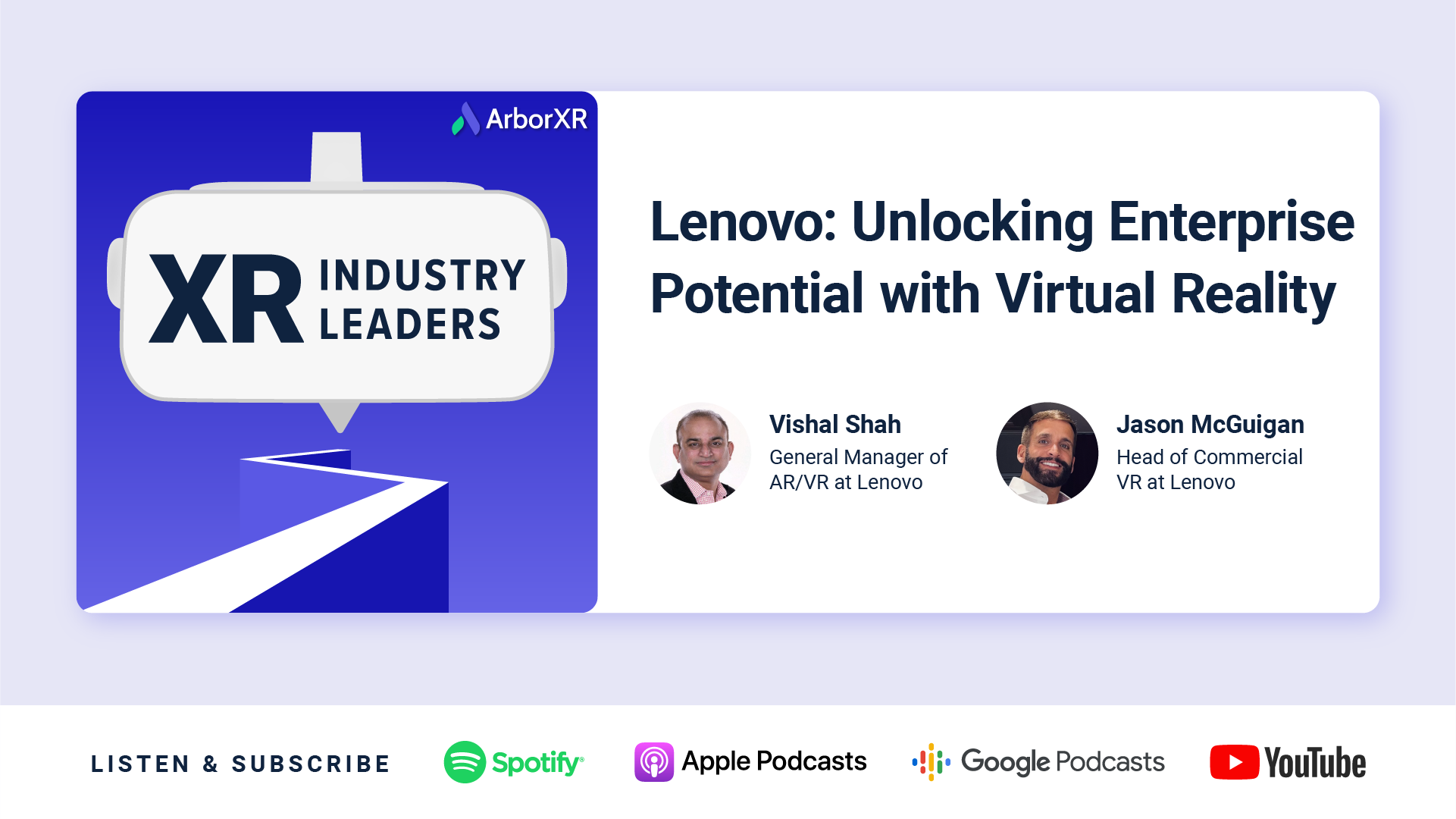
Lenovo: Unlocking Enterprise Potential with VR
Dive into the dynamic world of extended reality (XR) with Lenovo’s Vishal Shah and Jason McGuigan as they unravel Lenovo’s new enterprise XR solution: the Lenovo ThinkReality VRX.

PICO: Practical Enterprise Applications in XR at Scale
Explore XR’s future with PICO’s Amir Khorram in XR Industry Leaders. Insightful discussion on VR enterprise solutions, partnerships, and industry adoption.
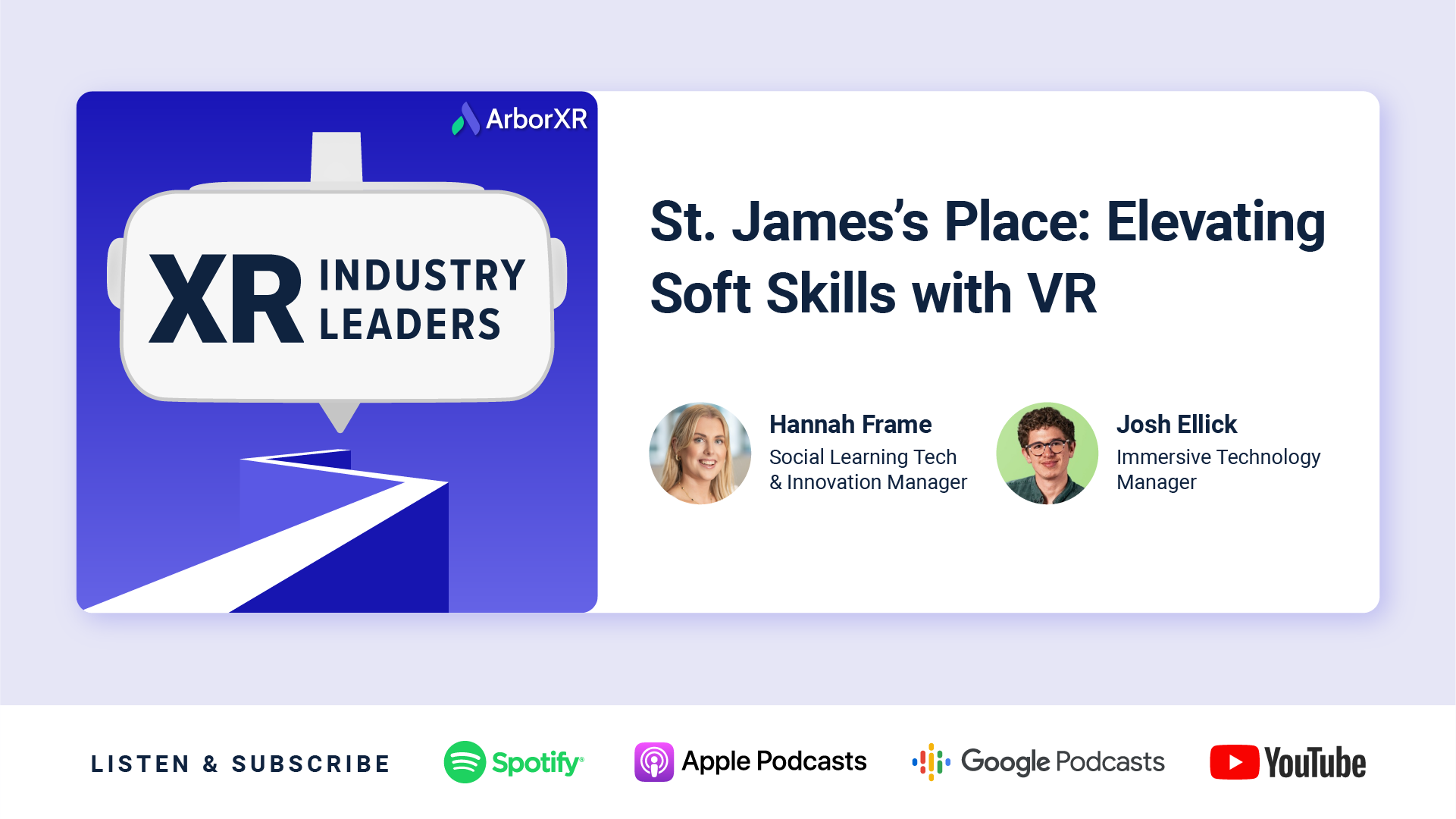
St. James’s Place: Elevating Soft Skills with VR
Hannah & Josh St. James’s Place discuss using VR to train advisor soft skills, challenges of managing headsets at scale, lessons on user adoption, and content development.
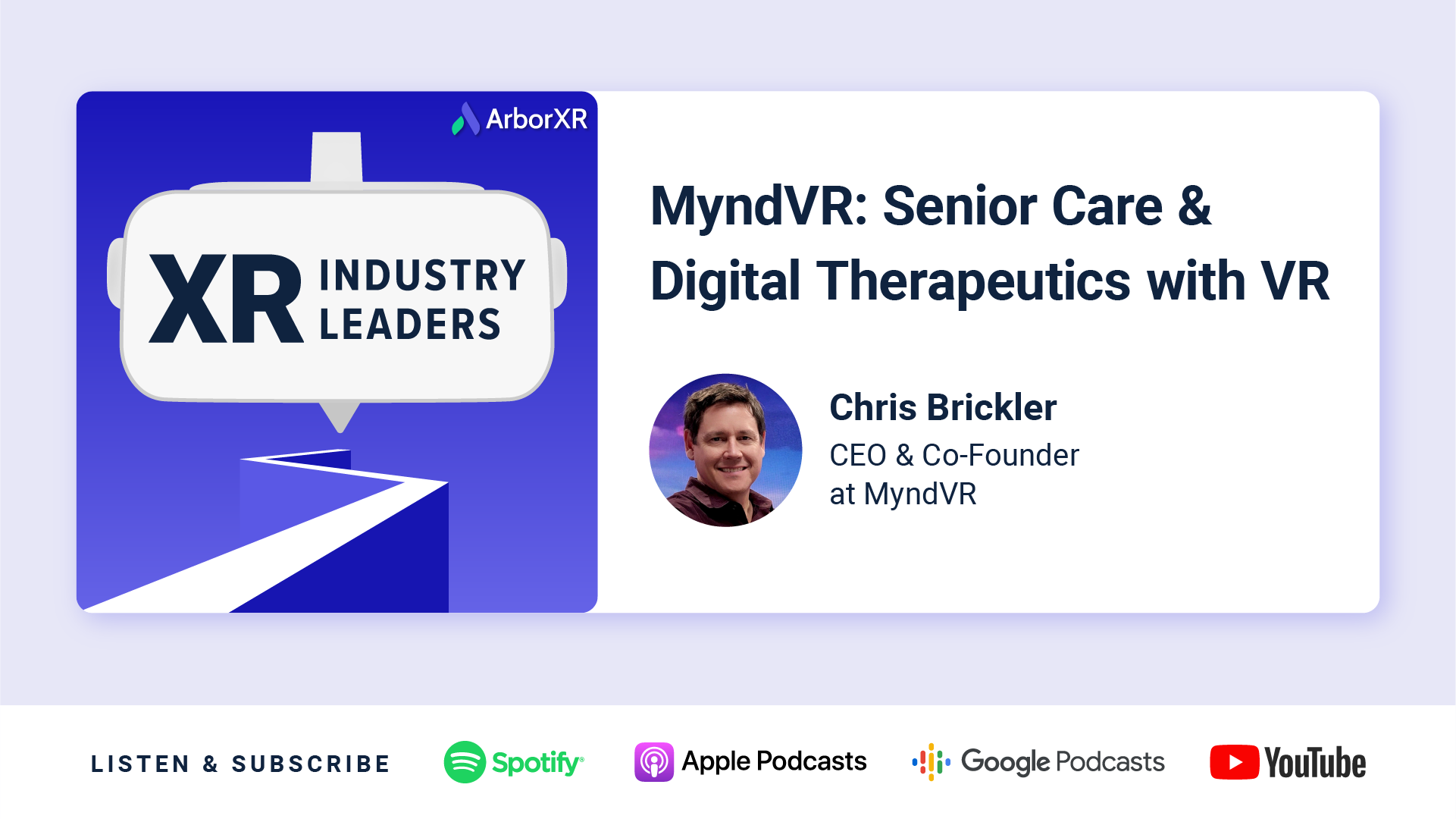
MyndVR: Senior Care and Digital Therapeutics with VR
Chris Brickler shares how VR therapy improves memories and care for elderly patients, and the challenges of scaling VR across health senior care facilities.
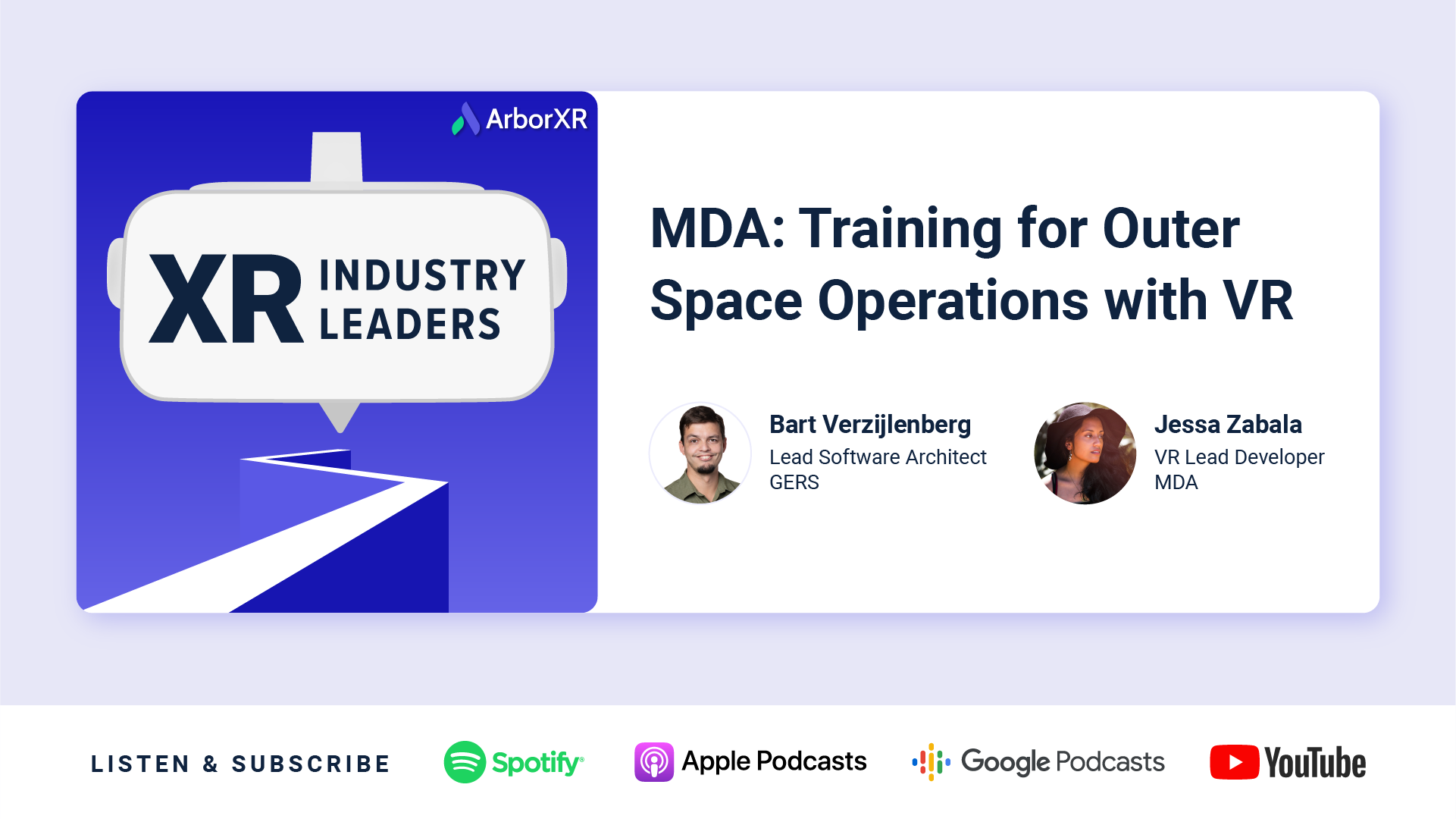
MDA: Training For Outer Space Operations with VR
Discover how MDA leverages VR for astronaut training, mission planning, and onboarding. Gain valuable insights into implementing immersive technologies at scale.

Harvard: Experiential VR Learning in Education
Matt Cook from Harvard joins us to discuss how virtual & augmented reality are redefining higher education through customized immersive experiences.
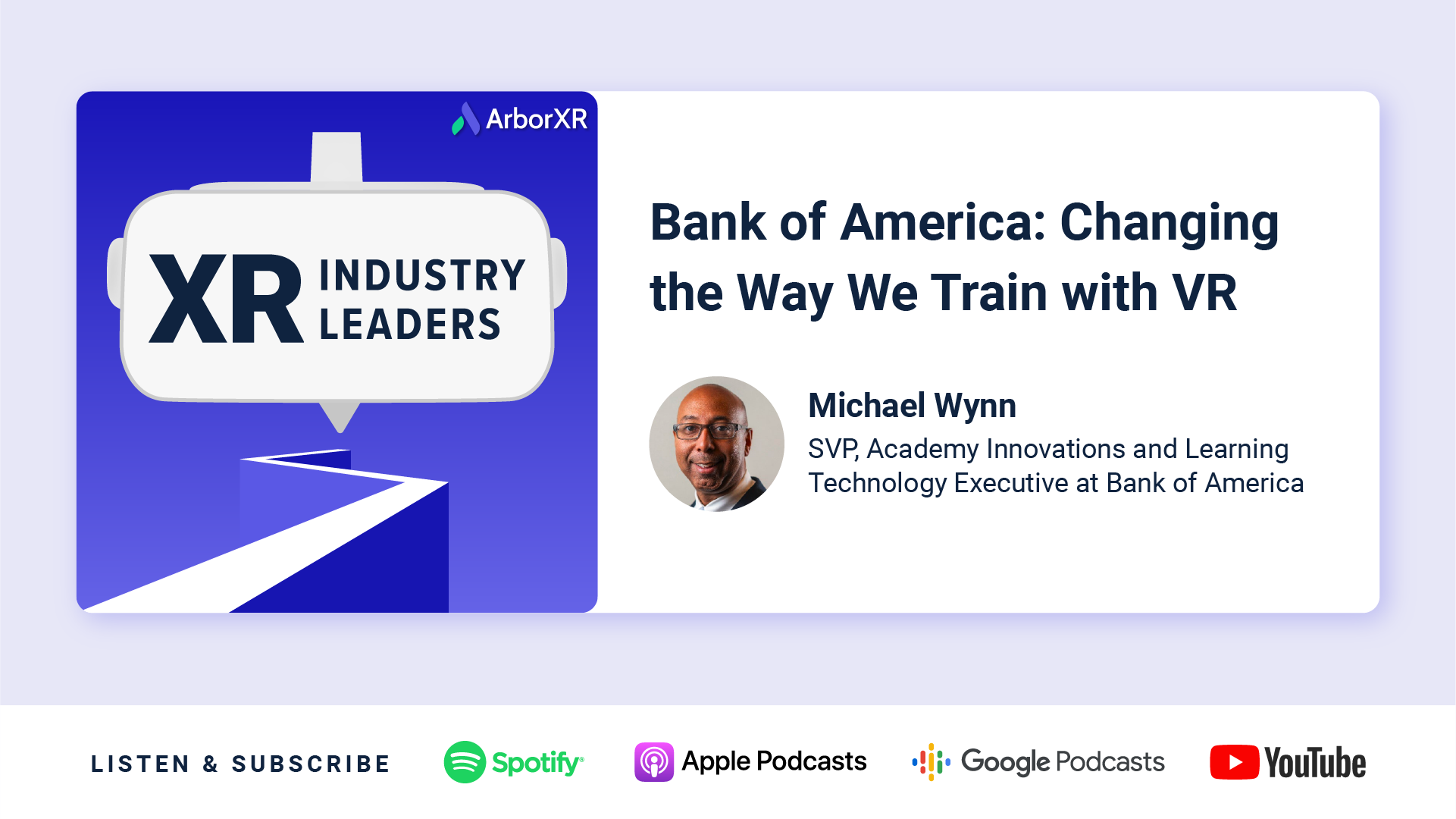
Bank of America: Changing the Way We Train with VR
Explore how Bank of America is revolutionizing training with VR, enhancing employee engagement, overcoming challenges with VR, and redefining corporate education.
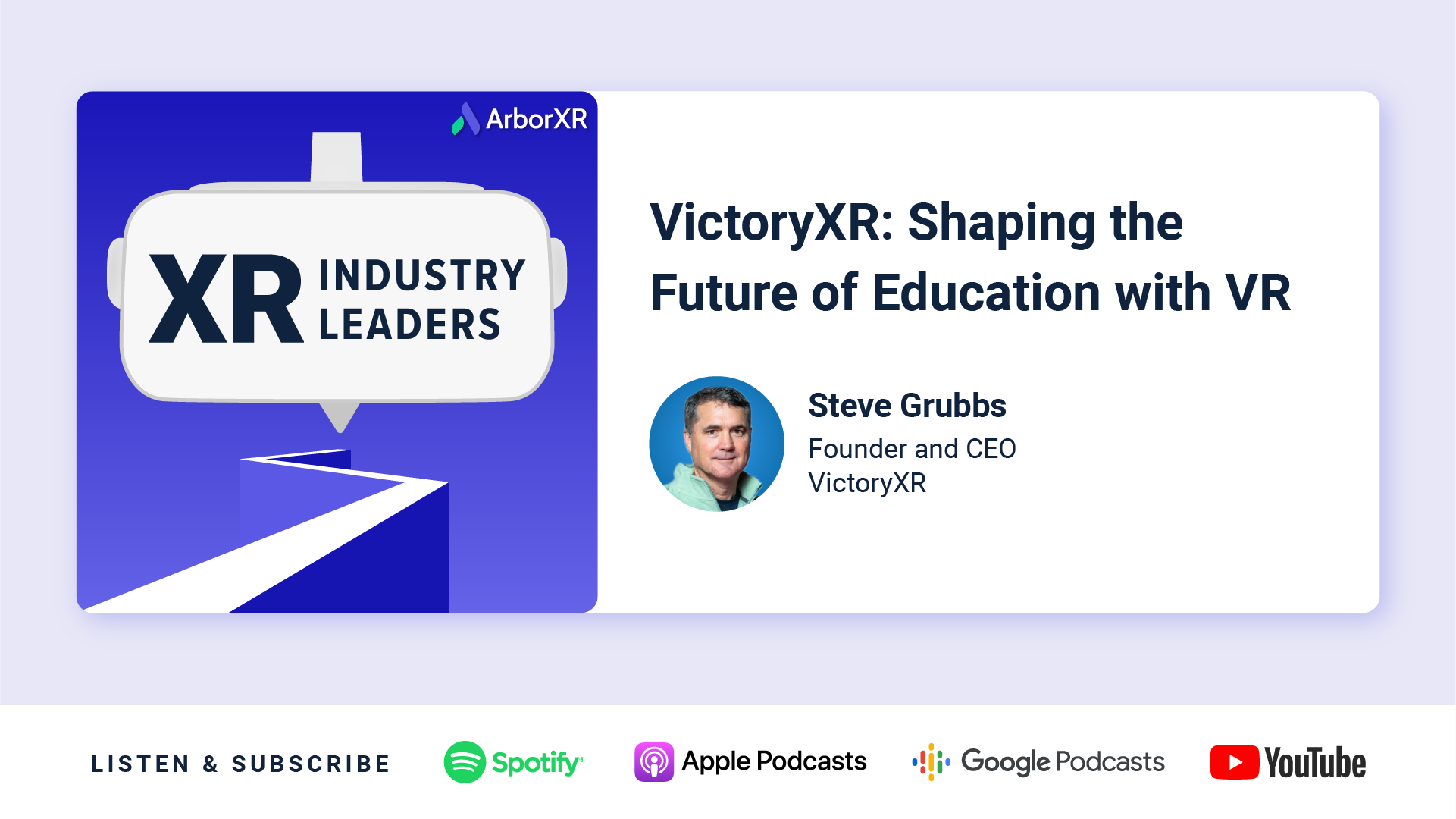
VictoryXR: Shaping the Future of Education with VR
VictoryXR CEO Steve Grubbs discusses creating virtual reality curriculums for education, working closely with Meta, and the future of immersive technology for teachers and students.

VRpatients: Designing Your Own VR Training for Healthcare
Learn how VRpatients creates VR simulations that instructors can customize to give trainees real-life experiences in healthcare.
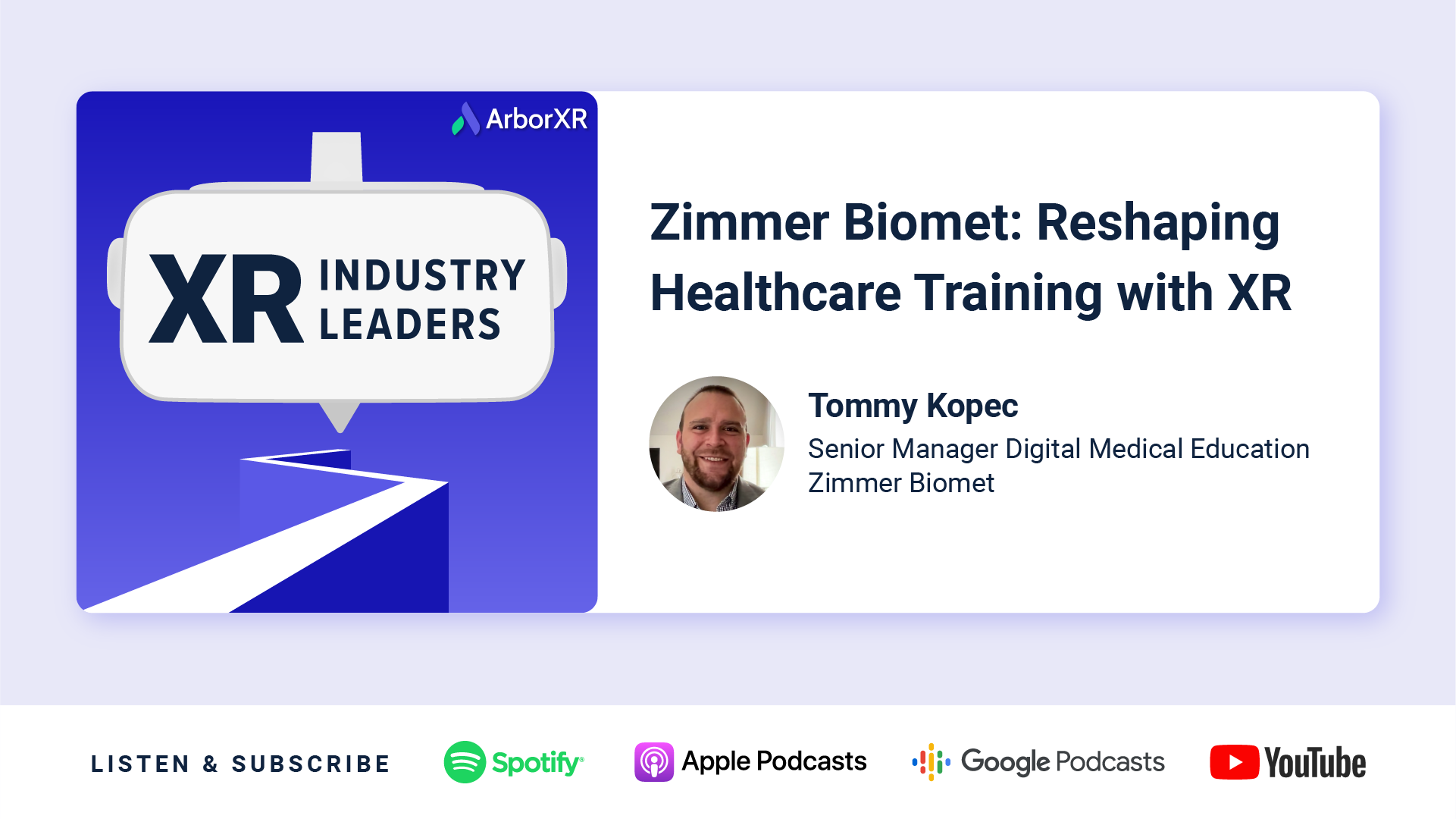
Zimmer Biomet: Reshaping Healthcare Training with AR and VR
If you’re interested in how XR will shape medicine going forward, this is a must-listen episode. Tommy Kopec of Zimmer Biomet provides an insider’s perspective on VR’s transformative potential for surgery, training, and beyond.
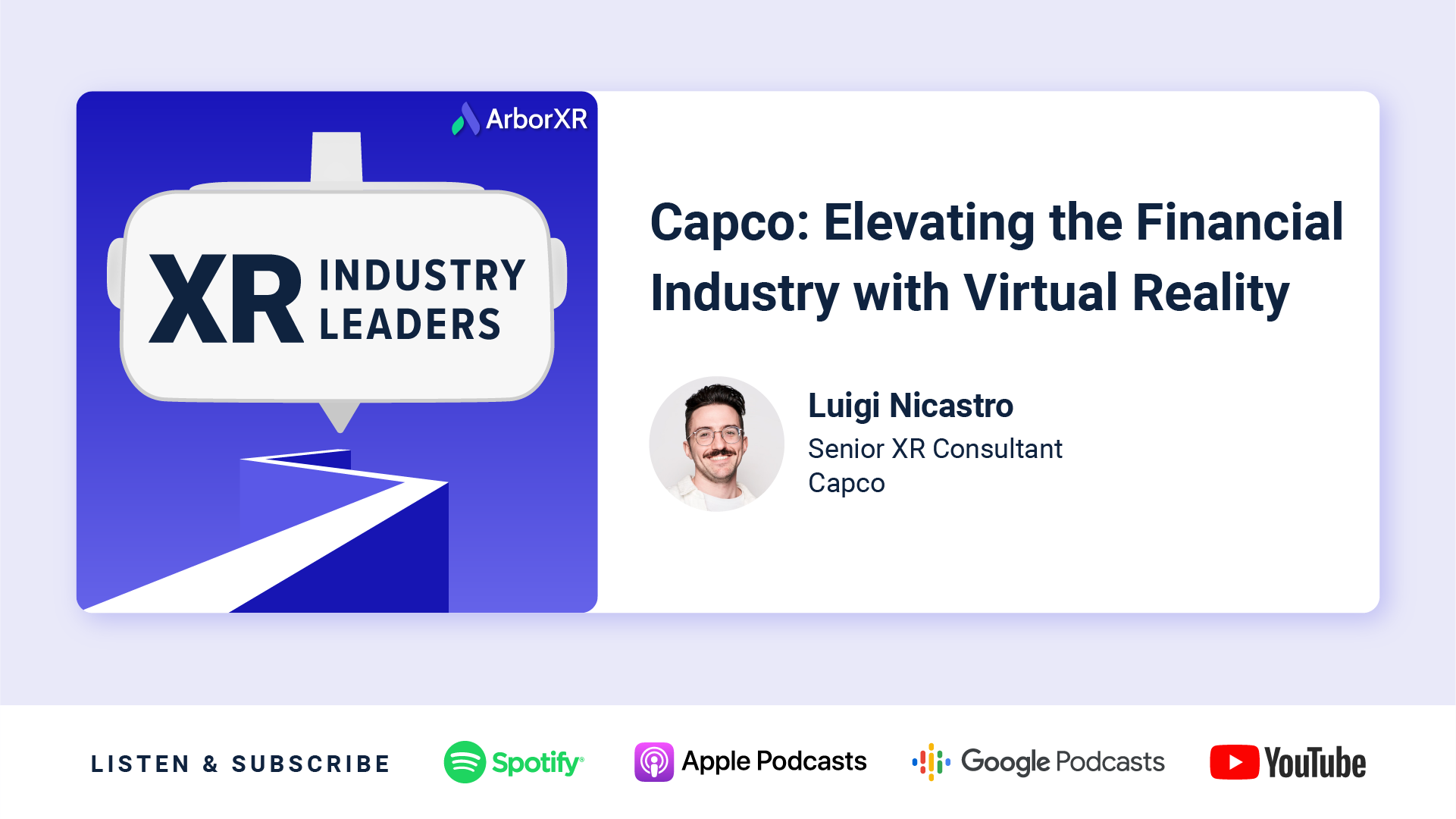
Capco: Elevating the Financial Industry with Virtual Reality
Explore how Capco revolutionizes the financial industry with virtual reality. Discover their success, challenges, and predictions for VR’s impact.

MIT: Exploring Extended Reality in Historic Operas
Discover how MIT uses AR and VR to create immersive experiences for historic operas. We discuss XR in education, challenges and advice for new adopters, and more.

Magic Leap: How Augmented Reality is Elevating Enterprise
Discover how Magic Leap is taking augmented reality to the next level with their enterprise-focused hardware, including real-world statistics and use cases.

Bodyswaps: Innovating Soft Skills Training with Virtual Reality
Discover the future of VR in education with Bodyswaps. Learn how VR elevates soft skills training, and how to implement VR technology effectively.
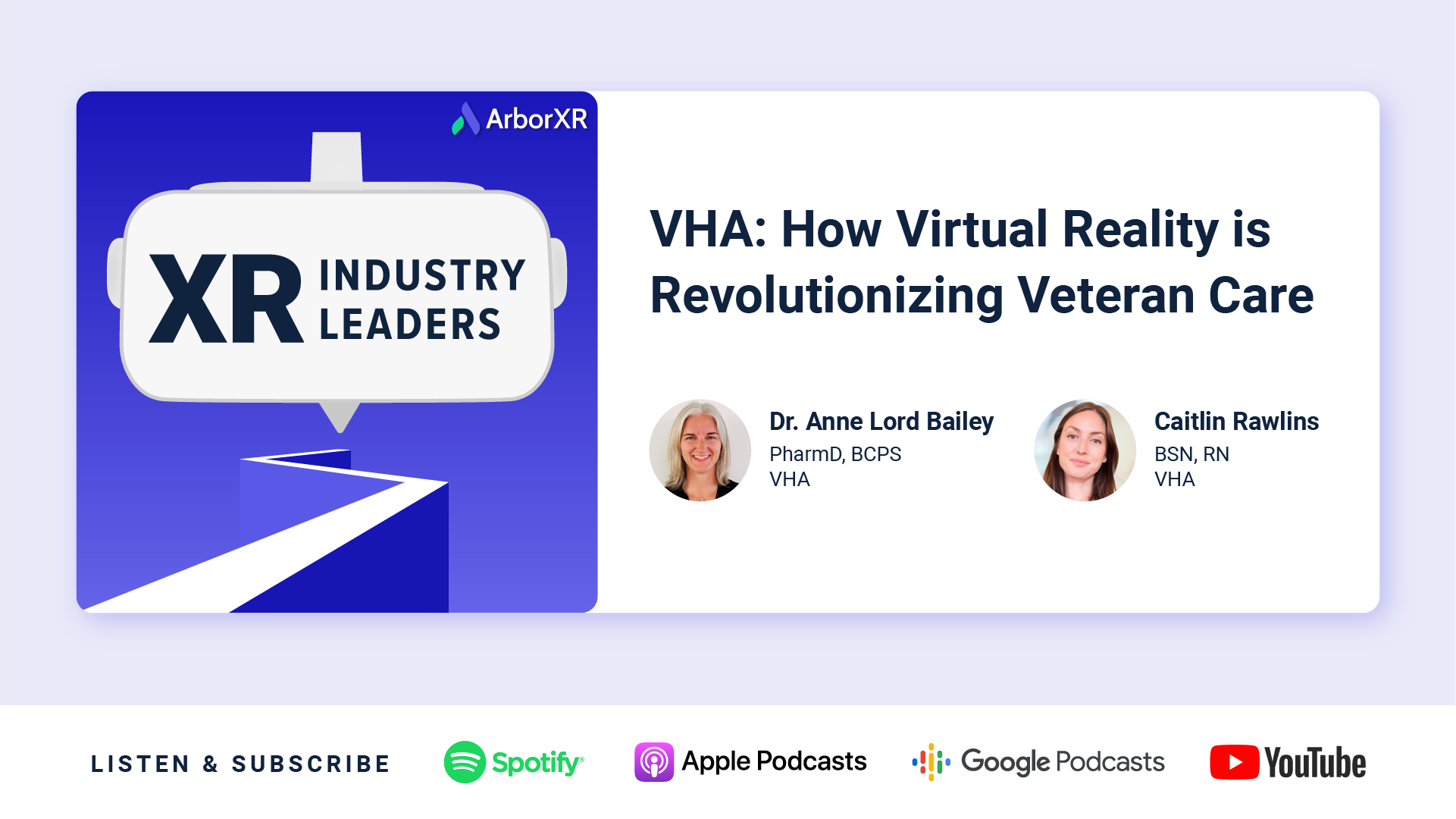
VHA: How Virtual Reality is Revolutionizing Veteran Care
Discover how the VHA is using virtual reality to improve the lives of veterans with pain management, mental health, and overall well-being.
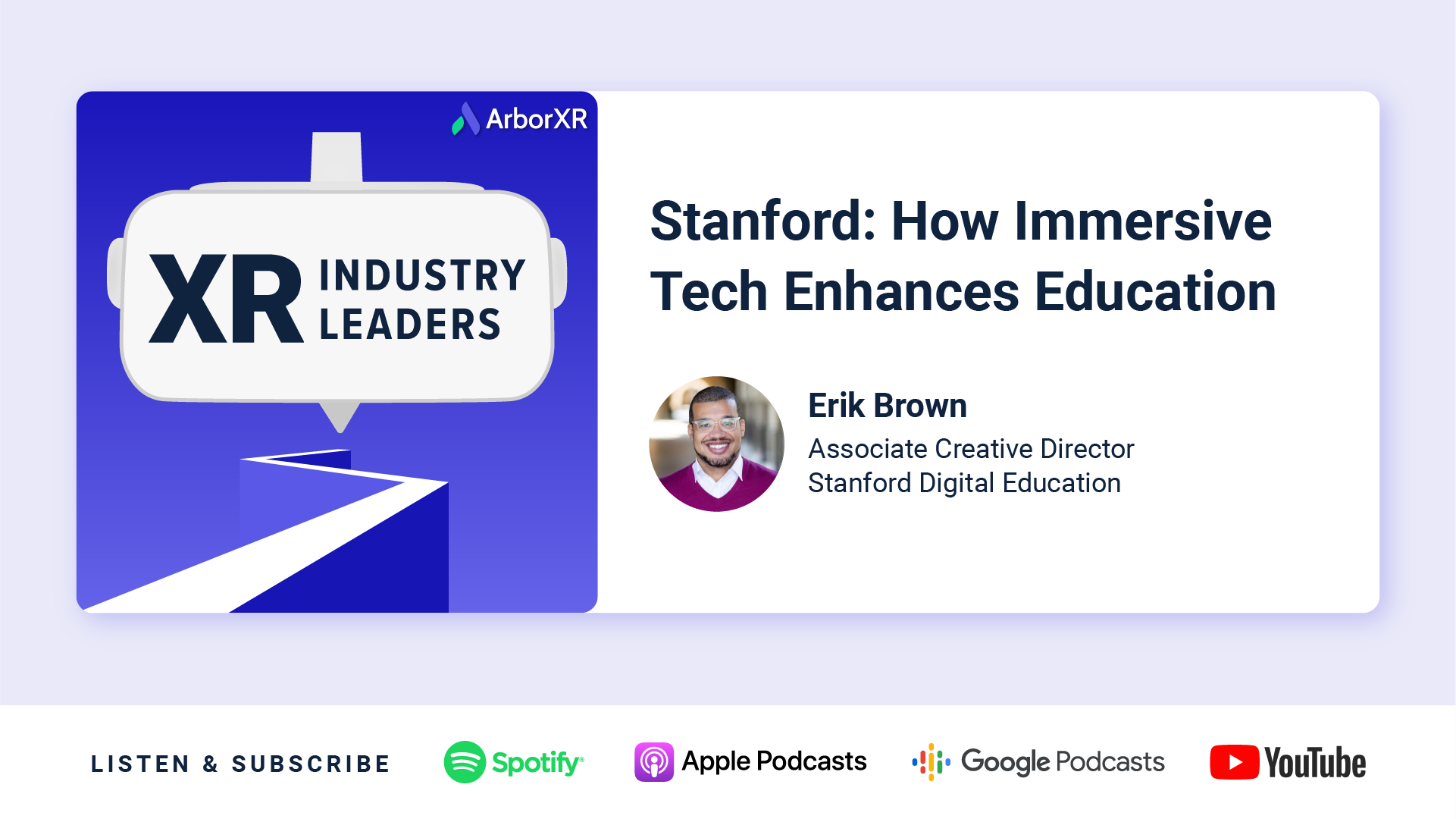
Stanford: How Immersive Technology Enhances Education
Erik Brown discusses how Stanford uses virtual reality for education, empathy in VR, challenges with creating and managing XR content, and more.
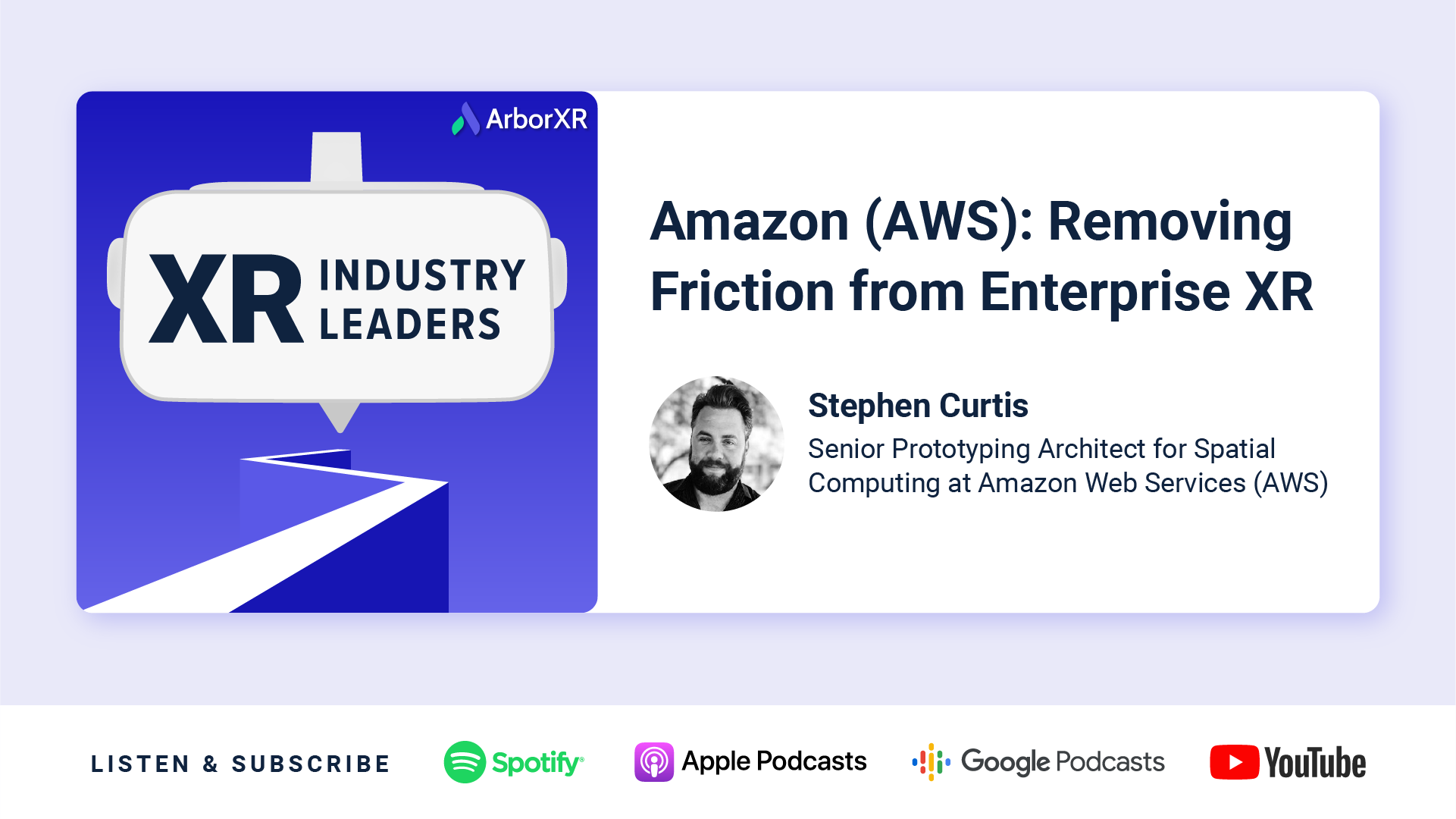
Amazon (AWS): Removing Friction from Enterprise XR
Stephen Curtis from AWS discusses how XR solves enterprise friction, advice for new adopters, XR content authoring, XR device management and more.

WestRock: How XR is Accelerating Manufacturing
XR champion Scott Burkey discusses the impact AR and VR is having on manufacturing, challenges implementing new technology, and advice for using XR in business.

Pfizer: Transforming How We Train with XR
XR leader Nicholas Hockley discusses how XR transformed the way Pfizer trains, challenges with AR/VR content, moving from a pilot program to scale, and more.
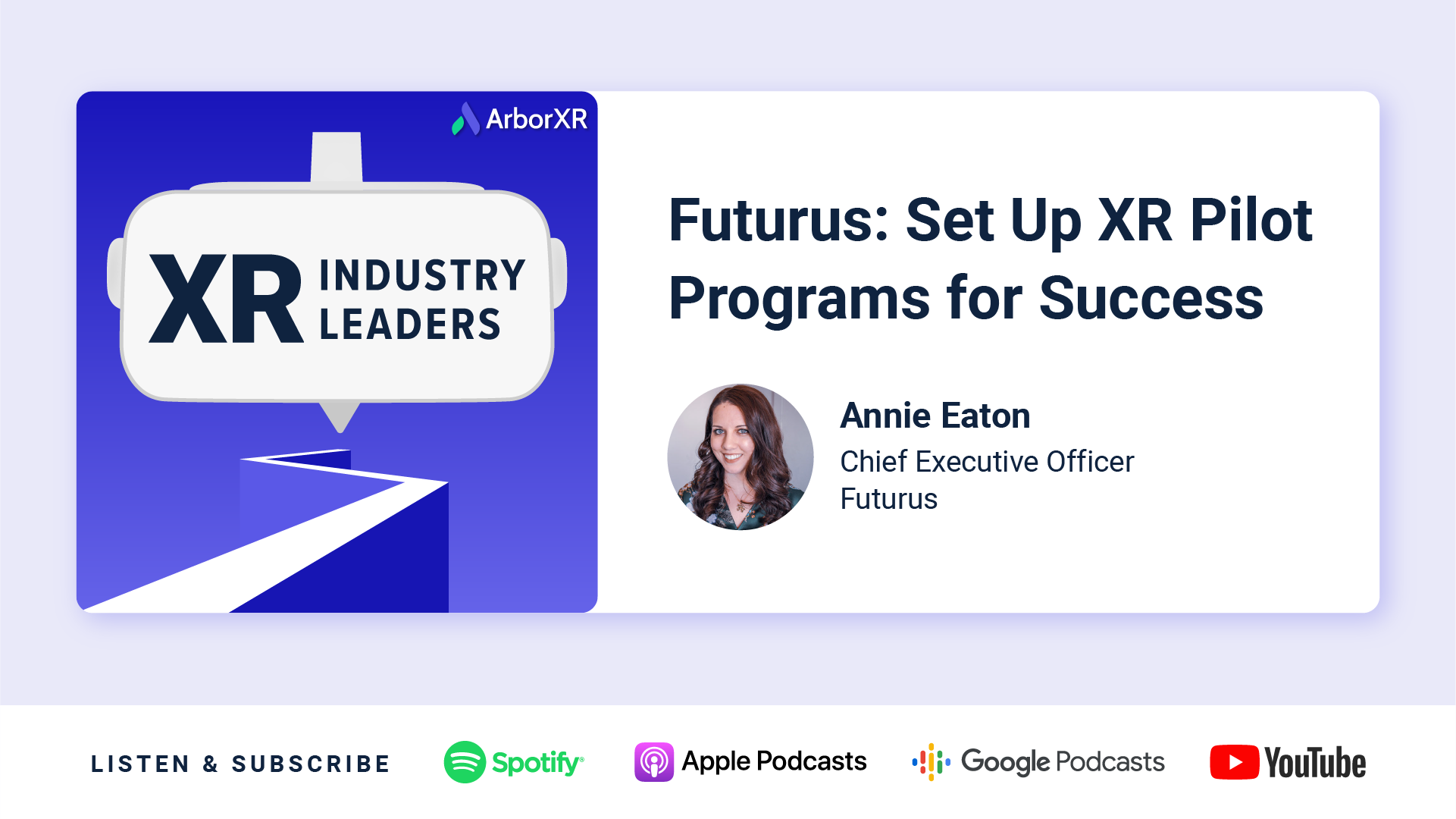
Futurus: Set Up XR Pilot Programs for Success
Futurus CEO Annie Eaton discusses creating AR/VR content, how to set up XR pilot programs for success, challenges in XR, advice for new adopters, and more.
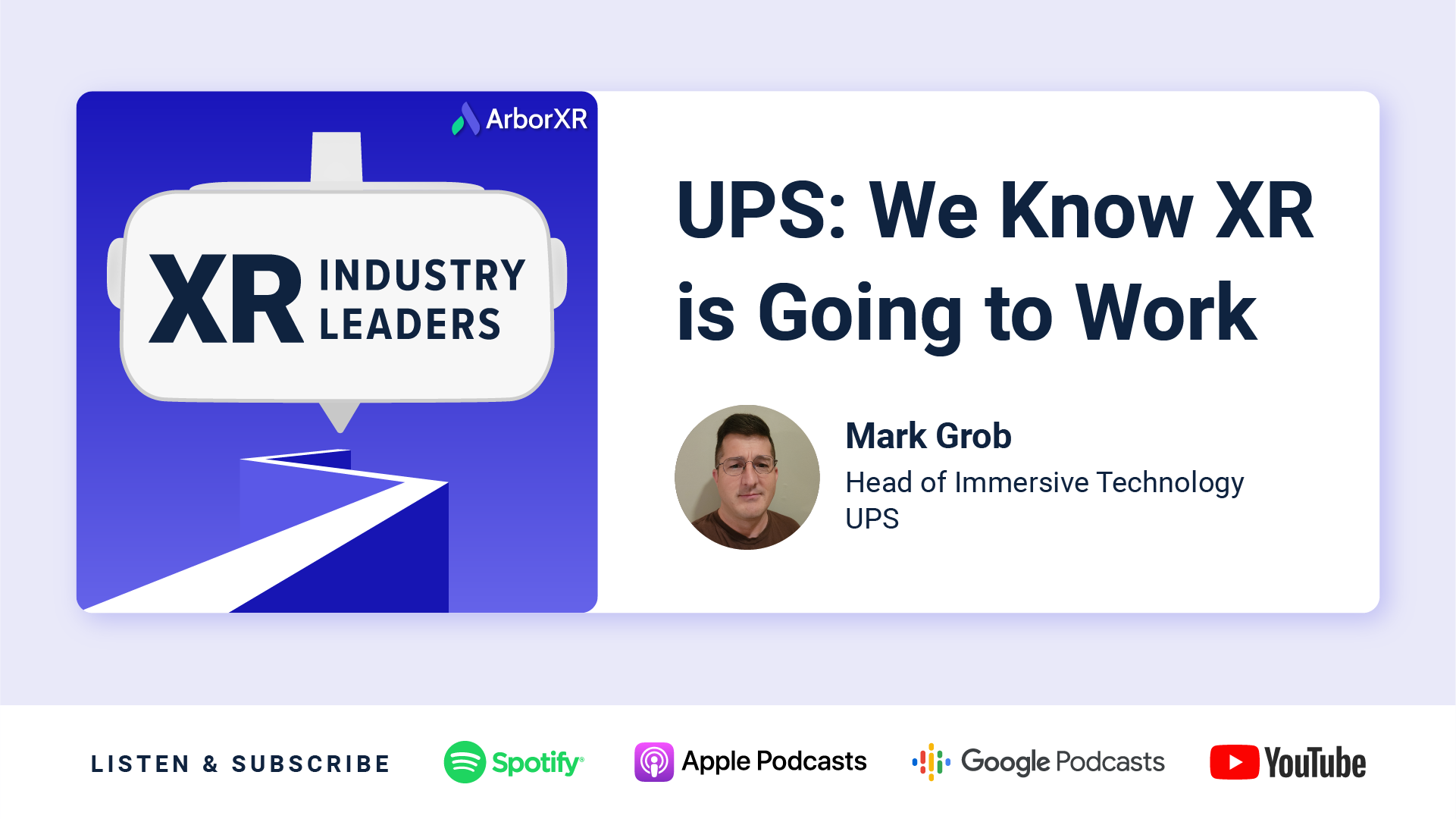
UPS: We Know XR is Going to Work
Learn how UPS built XR training as a practice. We discuss using AR/VR in business, challenges and benefits of XR training, advice for new adopters & more.

INVISTA (Koch Industries): What if We Reimagined Our Entire Training Process?
Learn how XR is transforming INVISTA (Koch). We discuss using AR/VR in business, challenges and benefits of XR training, strategy to scaling XR adoption & more.

Lenovo: Unlocking Enterprise Potential with VR
Dive into the dynamic world of extended reality (XR) with Lenovo’s Vishal Shah and Jason McGuigan as they unravel Lenovo’s new enterprise XR solution: the Lenovo ThinkReality VRX.

PICO: Practical Enterprise Applications in XR at Scale
Explore XR’s future with PICO’s Amir Khorram in XR Industry Leaders. Insightful discussion on VR enterprise solutions, partnerships, and industry adoption.

St. James’s Place: Elevating Soft Skills with VR
Hannah & Josh St. James’s Place discuss using VR to train advisor soft skills, challenges of managing headsets at scale, lessons on user adoption, and content development.

MyndVR: Senior Care and Digital Therapeutics with VR
Chris Brickler shares how VR therapy improves memories and care for elderly patients, and the challenges of scaling VR across health senior care facilities.

MDA: Training For Outer Space Operations with VR
Discover how MDA leverages VR for astronaut training, mission planning, and onboarding. Gain valuable insights into implementing immersive technologies at scale.

Harvard: Experiential VR Learning in Education
Matt Cook from Harvard joins us to discuss how virtual & augmented reality are redefining higher education through customized immersive experiences.

Bank of America: Changing the Way We Train with VR
Explore how Bank of America is revolutionizing training with VR, enhancing employee engagement, overcoming challenges with VR, and redefining corporate education.

VictoryXR: Shaping the Future of Education with VR
VictoryXR CEO Steve Grubbs discusses creating virtual reality curriculums for education, working closely with Meta, and the future of immersive technology for teachers and students.

VRpatients: Designing Your Own VR Training for Healthcare
Learn how VRpatients creates VR simulations that instructors can customize to give trainees real-life experiences in healthcare.

Zimmer Biomet: Reshaping Healthcare Training with AR and VR
If you’re interested in how XR will shape medicine going forward, this is a must-listen episode. Tommy Kopec of Zimmer Biomet provides an insider’s perspective on VR’s transformative potential for surgery, training, and beyond.
